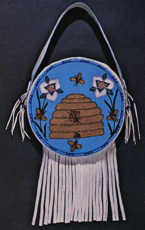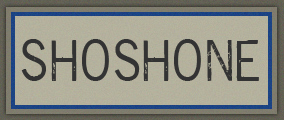Demographics
The Northwestern band of Shoshone received federal recognition and adopted a constitution and created a seven-member governing board in 1987. In 2002, there were 431 enrolled members of the Northwestern Shoshone in Idaho and Utah. The tribe owns 187 acres of land near Washakie, as well as some additional private lands. The Northwestern Shoshone have offices in Pocatello, Idaho, to serve those living in the southern Idaho, and Brigham City, Utah, to serve tribal members living in the northern Utah.
History
 The Northwestern Band of Shoshone is a branch of the larger group of Shoshone people that cover Utah, Idaho, Wyoming, and Nevada. The Shoshone people were very mobile and skilled at hunting and gathering, and with each change of the season they migrated to obtain the food and other resources they depended on to survive. Based on their migration patterns, experts have claimed that the Northwestern Shoshones were among the most ecologically efficient and well-adapted Indians of the American West.
By the 1840s, the Northwestern Shoshones had adopted some aspects of Plains Indian culture, using the horse for mobility and to hunt large game, such as buffalo. The Shoshone way of life came under attack when Anglo emigrants began to transverse Shoshone lands on the trails to California and Oregon in the early 1840s. The arrival of the members of the LDS Church in 1847 brought added pressure. Conflict between the Shoshones and whites became a serious problem in the late 1850s and early 1860s.
Violence erupted on January 29, 1863 when Colonel Patrick Edward Connor and about two-hundred army volunteers attacked a group of 450 Shoshone men, women, and children were camped on the Bear River twelve miles from Franklin, Washington Territory (now Idaho). In the early hours of the morning, Connor and his men surrounded the Shoshones and began a four-hour assault on the virtually defenseless group. Some 350 Shoshones were slaughtered by the troops, including many women and children. This was one of the most violent events in Utah’s history and the largest Indian massacre in U.S. history.
The Northwestern Band of Shoshone is a branch of the larger group of Shoshone people that cover Utah, Idaho, Wyoming, and Nevada. The Shoshone people were very mobile and skilled at hunting and gathering, and with each change of the season they migrated to obtain the food and other resources they depended on to survive. Based on their migration patterns, experts have claimed that the Northwestern Shoshones were among the most ecologically efficient and well-adapted Indians of the American West.
By the 1840s, the Northwestern Shoshones had adopted some aspects of Plains Indian culture, using the horse for mobility and to hunt large game, such as buffalo. The Shoshone way of life came under attack when Anglo emigrants began to transverse Shoshone lands on the trails to California and Oregon in the early 1840s. The arrival of the members of the LDS Church in 1847 brought added pressure. Conflict between the Shoshones and whites became a serious problem in the late 1850s and early 1860s.
Violence erupted on January 29, 1863 when Colonel Patrick Edward Connor and about two-hundred army volunteers attacked a group of 450 Shoshone men, women, and children were camped on the Bear River twelve miles from Franklin, Washington Territory (now Idaho). In the early hours of the morning, Connor and his men surrounded the Shoshones and began a four-hour assault on the virtually defenseless group. Some 350 Shoshones were slaughtered by the troops, including many women and children. This was one of the most violent events in Utah’s history and the largest Indian massacre in U.S. history.
In the aftermath of the Bear River Massacre, white settlers moved unopposed into traditional Northwestern Shoshone lands. The few remaining Northwestern Shoshones lost their land base and could no longer sustain their traditional nomadic lifestyle. In 1876, using rights guaranteed under the Homestead Act, the Northwestern Shoshones acquired and settled land just south of Portage, Utah. They named the farm after their admired leader Washakie, and the settlement, which was managed by members of the LDS Church, was home the Northwestern Band of Shoshone for the next eighty years. Tragically, in the summer of 1960, representatives of the LDS Church, who mistakenly believed that Washakie had been abandoned, burnt the Shoshones’ houses to the ground. The church later gave the band 184 acres of land near Washakie to atone for this mistake. In 1987, the government recognized the Northwestern Band of Shoshone as independent, and the Northwestern Shoshones adopted a constitution and tribal council. In addition to the Washakie land, the tribe holds some private lands held in trust by the Bureau of Indian Affairs.
Language and Culture
The Northwestern Band of Shoshone is part of the Northern Numic speaking peoples. They are closely related to the other Shoshone tribes and the Goshutes of Western Utah and Eastern Nevada. They looked upon the earth not just as a place to live; they called the earth their mother because she was the provider of all they needed for their livelihood. The mountains, streams, and plains stood forever, they said, and the seasons walked around annually. This belief is consistent with the Shoshone practice of moving with the seasons. Because the Shoshone had no written record, storytellers held very prominent positions and could recite detailed histories and stories of the Shoshone people.





